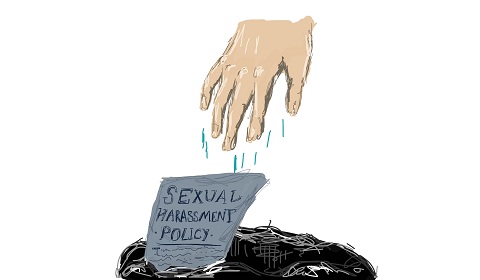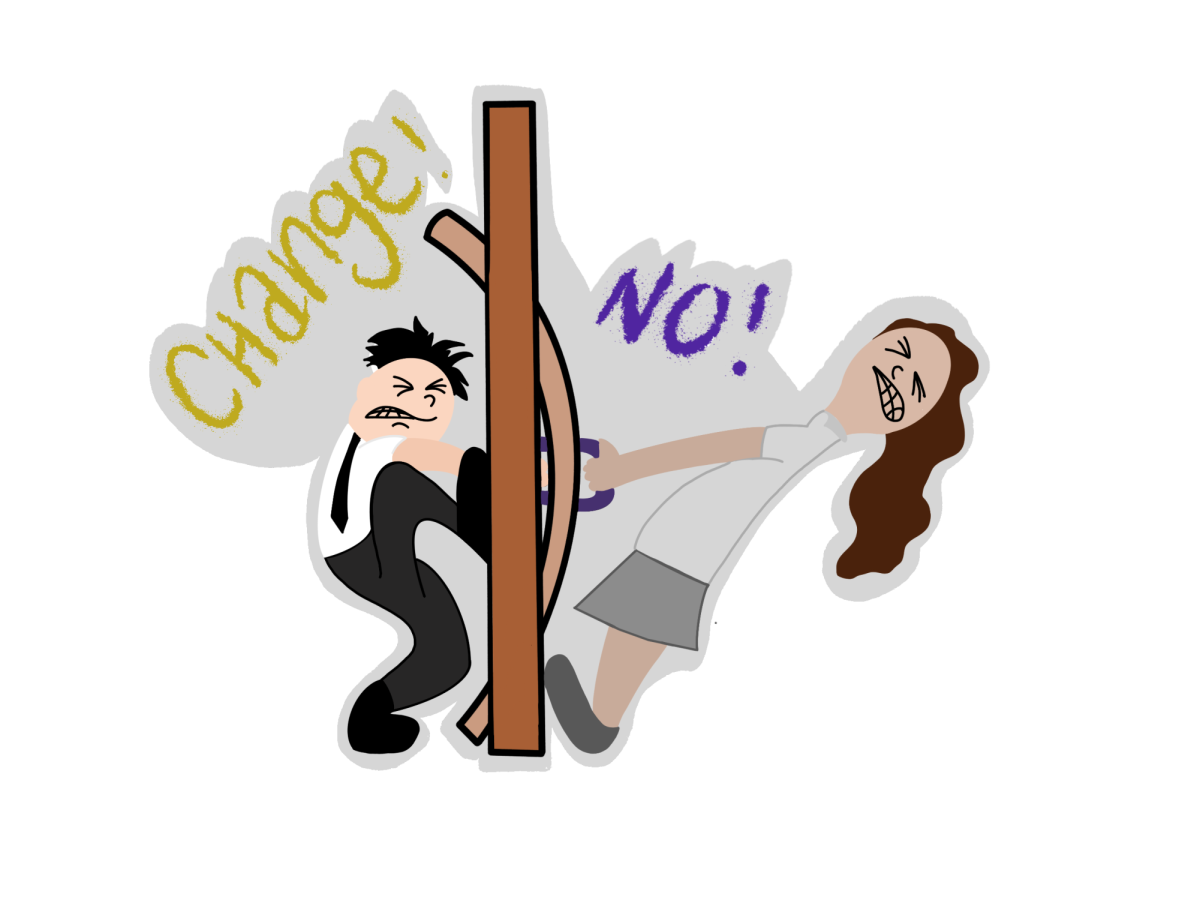
By: Margaret ’15 and Claudia ’15
In 2012, the police arrested Miramonte Elementary School teachers Mark Berndt and Martin Springer on charges of molestation and lewd acts with children. In August 2014, Los Angeles Unified School District (LAUSD) officials admitted that several school documents containing allegations of child abuse, which officials previously stated had been shredded, did in fact exist, leading many to believe that Miramonte had covered up the inappropriate behavior of its teachers.
Miramonte and its sexual harassment scandal have continued to dominate the news, illustrating the ongoing, nationwide debate about the handling of sexual harassment cases in schools.
Sexual harassment of students by teachers is not uncommon in schools. In a 2011 national study that surveyed 2,000 students and was conducted by the American Association of University Women, nearly 50% of students in grades 7-12 reported experiencing some form of sexual harassment at school. Sexual harassment, according to the U.S. Department of Education, is “unwelcome” behavior that is sexual in nature. It can be physical, verbal or nonverbal.
Recent cases of sexual harassment in schools have led many people to wonder who is to blame and have raised questions about the effectiveness of school policies in preventing and dealing with cases of sexual harassment.
What systems are in place to protect students from sexual harassment? What is the process for reporting and resolving cases of harassment, and what options are available to students and their families? What are the factors at play in a school’s decision to fire a teacher?
SHIELDING STUDENTS
A combination of state laws, federal laws and school policies aims to protect students from sexual harassment at school.
Title IX is a federal civil rights law that “prohibits discrimination on the basis of sex in federally funded education programs and activities,” according to the U.S. Department of Education Office for Civil Rights. Because all public schools in the nation receive some form of federal funding, Title IX protects public school students from discrimination based on sex and, by extension, from sexual harassment of any kind.
Private schools, in contrast, often do not receive federal funding and thus are not covered by Title IX. However, according to Skye Daley, an attorney who represents victims of childhood sexual abuse at Manly, Stewart & Finaldi, both state laws and federal laws apply to private schools and serve the same function as Title IX. For instance, section 28, article 1 of the California Constitution declares that in all California schools, “students and staff have the right to be safe and secure in their persons.”
“Basic laws that protect you from hurting other people apply to everybody… So [the laws] are not school-specific, but they certainly do protect children from being abused by adults,” Daley explained.
Students at private schools can also be protected against sexual harassment by school-specific policies that define sexual harassment and outline protocols for reporting and dealing with cases of harassment.
Peter Christian, Dean of Staff and Director of Human Resources at Windward School in Los Angeles, explained the importance of having a school sexual harassment policy.
“The more clarity you can provide students or anybody in your community on how you would handle situations like that is great. People tend to be more reassured when they can see what’s going to happen,” Christian said.
These policies do not have to be uniform across private schools, however, which occasionally results in discrepancies in terms of the language of the policies and how often schools update them.
Brentwood School, for example, has two sexual harassment policies. One is designed for students and covers harassment among students as well as harassment by teachers. The second policy is written for employees and prohibits harassment among employees and employee harassment of students. These policies contain specific guidelines for how students should report harassment and are printed in a family handbook for students and their families, a faculty handbook and a staff handbook.
Until the 2014-2015 school year, Marlborough School did not have a specific sexual harassment policy that discussed harassment of students by employees. The pre-existing Student Handbook of Expectations, which every girl signs each year, does mention sexual harassment between students, and the Employee Handbook outlines rules prohibiting any kind of harassment between employees and requires that employees maintain “mature relationships” with students.
Marlborough’s new Student Anti-Harassment and Anti-Bullying policy defines harassment, including sexual harassment, and provides guidelines for reporting and investigating inappropriate behavior.
Some, however, point out that a policy may be rendered ineffective by a lack of enforcement.
“What’s silly is the notion that…because this teacher has signed a sexual harassment policy promising not to sexually harass students, that that alone is enough,” Daley said. “So the problem isn’t that there’s no policy, the problem is that schools in these cases don’t execute their policies.”
ALLEGATION TO LITIGATION
The process for reporting and investigating sexual harassment or misconduct involves school administrations and the legal system.
Although private schools have no federal requirement to have a school wide sexual harassment policy, most schools have their own methods for dealing with allegations of sexual harassment.
Windward, for example, uses an in-house counseling department and a peer counseling program to investigate students’ allegations of harassment. If a student reports an incident of misconduct to a peer counselor, the peer counselor then relays the allegations to an adult member of the counseling department.
Occasionally, however, schools fail to follow through with proper investigations. According to The Los Angeles Times, Berndt’s inappropriate behavior at Miramonte began as early as 1983, but the changing administrations at the school over the past three decades failed either to keep an ongoing public record of the happenings or to take the claims seriously until decades later.
Rather than approach schools to take action, victims’ families often seek legal justice. Daley said that conflicts of interest may impede in-house investigations at institutions, prompting families to reach out to lawyers.
“The truth is that any entity, whether it’s a school or a company or church, if they have a problem, they would rather deal with it themselves. You know [the schools] don’t necessarily want to invite bad publicity…Sometimes it just makes sense to go directly to the police or to hire a lawyer,” Daley explained.
Leslie Wallis, an employment law attorney for the firm of Ogletree Deakins, maintained that schools’ best interests do in fact lie in seeking legal guidance for investigating allegations.
“Because [schools] contact a lawyer does not mean… that the public will be aware of it. If they are wise, they’re going to contact a lawyer who may or may not end up negotiating or discussing with the family or the student right away,” Wallis said. “[The lawyers] may be advising the school how to proceed.”
If families opt to take legal action, they can sue the school or the accused teacher. According to Wallis, the most common claims against schools are negligent supervision, negligent hiring, intentional infliction of emotional distress or negligent infliction of emotional distress
Sexual harassment cases can, however, involve limited legal intervention. After Mikaela Gilbert-Lurie ’13 published a personal essay on XOJane.com accusing former Marlborough English instructor Joe Koetters of inapropriate behavior, lawyers contacted the Gilbert-Lurie family to offer their assistance, but the family declined.
According to Mikaela’s mother, Leslie Gilbert-Lurie, the family never planned on involving a lawyer when talking with the School.
“Mikaela all along really wanted a sense of fairness and justice…Those are things that are sometimes easier to negotiate or talk about than get through the judicial system,” Gilbert-Lurie explained.
TO FIRE OR NOT TO FIRE?
If a school determines that an employee has engaged in inappropriate conduct, the actions that a school can take range from issuing a warning to terminating the employee’s contract. Some said they feel that the ambiguous language of contracts makes it easier for schools to avoid firing an employee.
Employees in the state of California are employed “at-will,” meaning that their contracts can be terminated at any time without reason or notice, as long as the firing is not on an illegal basis, such as discrimination based on gender.
Largely due to the “at-will” clause, many schools do not have specific guidelines outlined in employee contracts for what constitutes a fireable offense.
Brentwood’s Upper School Director Bob Cooke explained that having a specified set of rules would not fit with the unique nature of most cases.
“We don’t say if you do this, then that will happen… because each case is so unique. I don’t think you could possibly write something that would make sense,” Cooke remarked.
Daley said he believes that even very clear policies may not prevent a school from putting its public reputation before its students when determining whether or not to fire a teacher.
“You normally find somewhere in the history [of the sexual harassment case] a lapse in executing their own protocols… Maybe there was a prior complaint but no one did anything about it, and so the teacher continued to teach unrestricted,” Daley explained.
Wallis said, however, that if a school doesn’t adequately respond to inappropriate behavior by a teacher, and the behavior occurs again, the school has placed both itself and its students in a vulnerable position.
“You have to realize that it is therefore in the school’s interest in many cases, if they have a fairly good sense that there’s some validity to the claim, to get rid of the person… it’s not necessarily the most humane [route], but it is the easy route,” she said.
Wallis also pointed out that schools must weigh the validity of the claims brought against an employee when deciding whether or not to fire him or her.
“If a teacher gets fired for this kind of thing, you pretty much put the red “A” on their forehead. They’re never getting another job teaching,” Wallis commented.
Cathy Helm, an employment law attorney who advises Marlborough, explained that California has strict privacy laws that require all personnel decisions, including warnings and reasons for termination, to be kept confidential. Therefore, a future employer may not have access to information regarding an employee’s misconduct unless the behavior threatens others’ physical safety.
Helm added that schools would, however, be able to access the criminal records of a prospective employee through a background check, as all employees who work with children under 18 in California must be fingerprinted during the hiring process.
Many, like Daley, believe that an increased awareness of sexual harassment in schools has led to more reporting of the issue, which Daley sees as a positive trend.
“I think that we are looking for the problem now… It’s hard because no one wants to see it; it’s hard to look this problem in the face, but it’s good that we are,” Daley explained.










